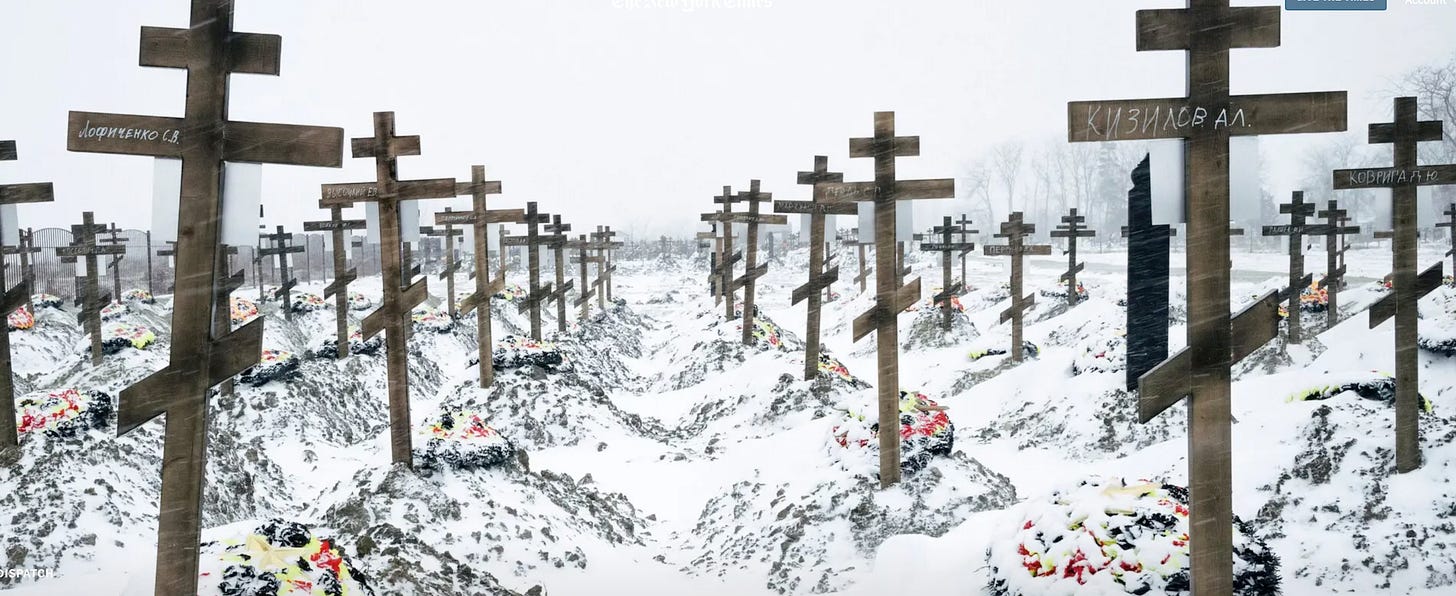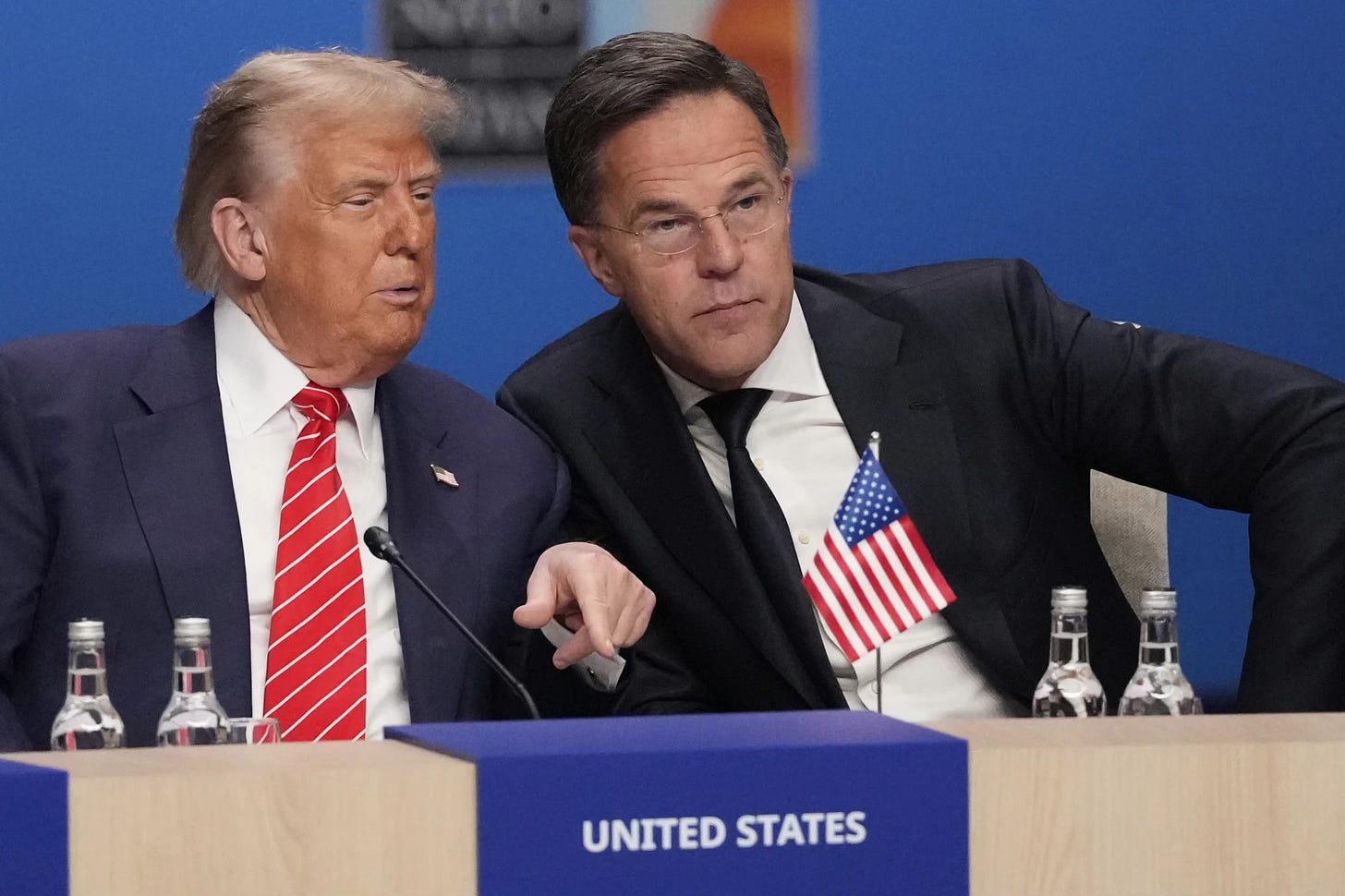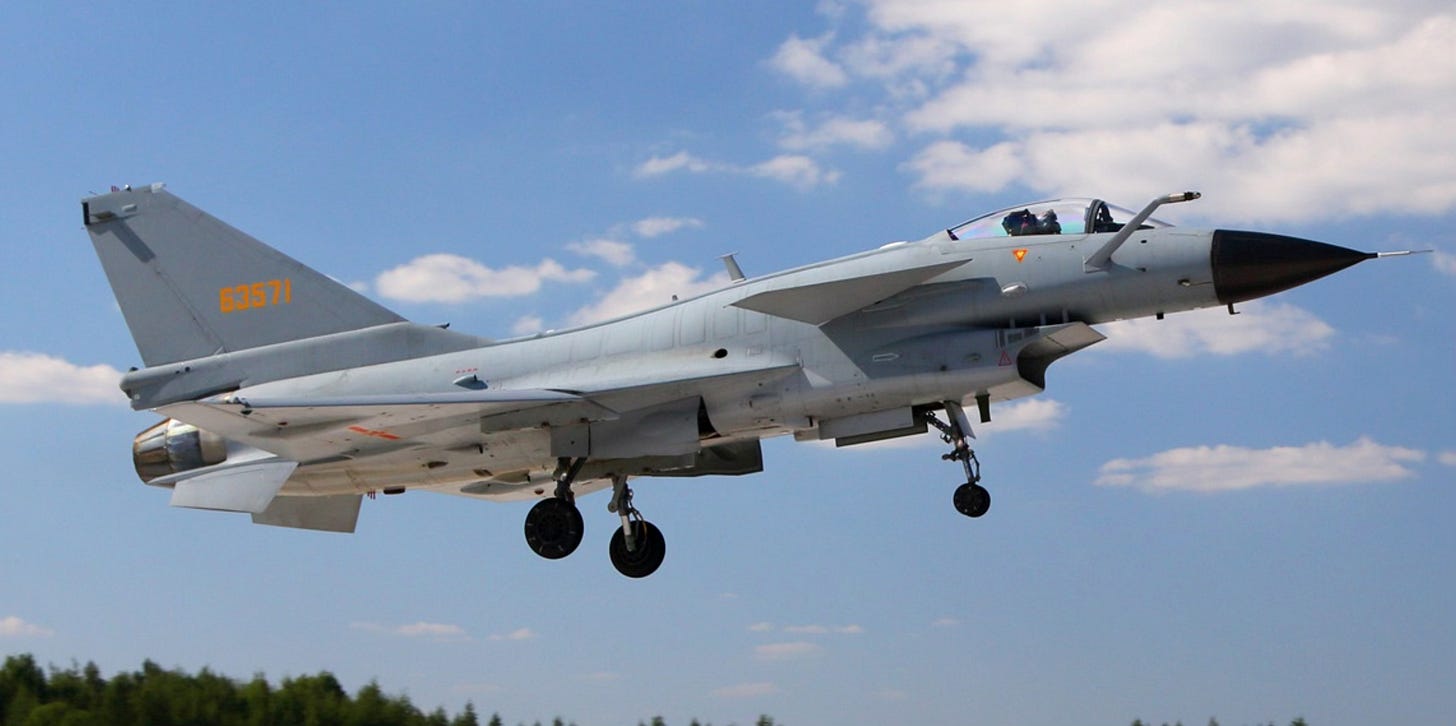Marching Toward the Abyss: Demobilization
One Million and Counting | Financial Cost | Political and Social Cost
Dear BWR Shoeshiners and Barbers!
IMPORTANT NOTICE: Please be aware that some e-mail servers (G-mail in particular) may truncate the BWR newsletter, thus depriving you of total enjoyment. If this problem occurs, please read BWR on the Substack platform to enjoy the full newsletter.
Follow BWR’s daily posts on the Blue Sky platform for daily updates and posts.
In last week’s BWR, I discussed Russia’s interests in the Iranian-Israeli War. The alliance of convenience with Iran has reached the end of its usefulness and is now becoming a liability.
In this week’s BWR, I will discuss the Kremlin’s growing debt and responsibility toward war veterans. The economic and social costs the government faces as soldiers reintegrate into society will be a significant challenge.
Takeaways
HUMAN CAPITAL—There are limits to how many soldiers Russia can send to the war without causing a public backlash and driving the country into financial ruin. The war has come to the Russian living room in more ways than one - casualties and reduced social services are just two.
FINANCIAL AND SOCIAL COST—The lifetime care for hundreds of thousands of returning veterans, saddled with post-traumatic stress disorder and missing limbs, is estimated to cost $209 billion over the course of 30 years. The current state of the healthcare system can not handle the tidal wave of healthcare needed for the next decade.
One Million and Counting
Putin’s war on Ukraine is clocking up casualties now approaching one million, with conservative estimates of 250,000 dead and 750,000 wounded. This is the highest war casualties since the Great Patriotic War, and occurring at a time when Russia is rapidly facing a demographic crisis fueled by an aging population, low birthrate, high emigration due to the war, and almost no immigration—also a consequence of the war. Compared to the Soviet Union’s Afghanistan war casualties of 65,000—15,000 deaths and 50,000 wounded.

To put this into perspective, the Soviet Union had a population of 286 million, while Russia’s current population is 145 million. This means one in 4,400 people was directly affected by the Soviet Union’s 10-year Afghan war. In comparison, one in 145 Russians has been directly impacted by Putin’s war on Ukraine, which is now in its third year.
Financial Cost
The direct one-time payments to Russo-Ukrainian war veterans so far are estimated at $62 billion. This amount only covers one-time death and disability payments to the families of deceased soldiers and to veterans, respectively. It does not include additional healthcare and social support expenses, which will likely double this figure over a veteran’s lifetime. For example, it is estimated that more than 1.5 million soldiers have rotated through the war, and according to Russian statistics, 54% of the returning veterans with disabilities are amputees. The amputees will need lifelong physical and psychological care. According to Deputy Defense Minister Anna Tsivileva, 20% of returning soldiers will suffer some form of post-traumatic stress disorder (PTSD). These veterans will also require lifelong care, and if not properly treated, will likely impose greater societal costs related to safety and security.

It is worth noting that, according to a 2023 World Bank report, the average life expectancy for a Russian male is 68 years. Various media outlets report that the average age of a Russian soldier today is 36 years. Assuming that war veterans have the same life expectancy as the general population, this means a disabled veteran would need about 32 years of lifetime care after returning from the war. As shown in the chart below, that amounts to roughly $209 billion in long-term care that must be provided by the Russian government, the veteran's family, or both.

The higher average age of Russian soldiers today indicates that Russia has lost a significant number of younger working-age people to the war, either through casualties or emigration. As a result, the Russian government must rely on costly, older contract soldiers and convicts in exchange for their freedom once their service contract is complete. The now dissolved Wagner Group was the trendsetter in recruiting convicts, a topic that will be discussed in the next section. The removal of millions of working-age individuals due to the war will also lead to productivity losses that accumulate over time and will become a semi-permanent drag on the Russian economy. Each disabled veteran not only adds a direct cost to the economy but also lowers overall productivity.
Aside from the cost of healthcare, there are also significant infrastructure and capacity issues with veterans’ healthcare. Since 2012, the number of hospitals has declined by nearly 20%, and there are only ten veteran hospitals in the country. According to Rand, the hospital that focuses on psychological rehabilitation has just 32 beds. A massive expansion of the Russian military hospital system will be needed to serve the hundreds of thousands of returning veterans, but it is unclear where the money and personnel will come from for such an expansion. More than 40% of the Russian Federal budget is allocated for the war and security services, all at the expense of social services.
Political and Social Costs
Putin’s war is directly impacting Russian families in many ways, and its effects will be felt for generations both inside Russia and abroad. The most immediate effect in Russia is the shrinking of the working-age population due to casualties and emigration caused by the war. Putin’s social contract with the people—stay out of politics, and I will provide a good standard of living and security—was broken when he invaded Ukraine. One in 146 Russians has been affected by the war, and daily attacks are occurring inside Russia, reaching as far as interior cities like Samara and Nizhny Novgorod. Moscow has not been spared from the war, with frequent airport closures. While these attacks raise questions about Putin’s ability to ensure security, the bigger problem and greatest threat to his power will be integrating war veterans, especially the criminals released from prison in exchange for combat service and freedom when their contracts are fulfilled.
Russia is already seeing a rise in crimes committed by prisoners who have been released after completing their military service contracts. For example, “Trouble at Home”, written by Mark Galeotti for The Global Initiative Against Transnational Crime, tells of one such story of a convicted murderer, Ilya Metlitsky, who was sentenced to 16 years in a maximum-security penal colony for murdering his girlfriend in St. Petersburg. He stabbed her 107 times and then took a selfie with the corpse. Ilya joined the Wagner Group in 2022 and was demobilized in 2023, only to commit another violent crime, after which the court considered his veteran status and decided to allow him to serve again in the military in exchange for freedom after his service. This is one of many such stories making the headlines in Russia today.

According to Ukraine's Foreign Intelligence Service (SZRU), the Kremlin has recruited up to 180,000 convicts from the prison system to fight in the war, and Russia’s prison population has decreased by roughly the same number. When the war winds down—and it will—the prisoners who survive will be released into society and will no doubt wreak havoc.
Another consequence of the war will be the spread of illegal weapons in Russia, neighboring countries, and even farther abroad. This is a common occurrence that happens over time in and around war zones. I remember in the early 90s in Saratov, dining with a local businessman and his friends, they proudly showed me the weapons they had brought back from Afghanistan, including an RPG (shoulder-held rocket-propelled grenade launcher).

The Chechen wars also led to a proliferation of illegal weapons brought home by demobilized soldiers in the 1990s and early 2000s. In the absence of proper healthcare and jobs for the returning veterans from these wars, mafia groups were provided with a large talent pool of trained young men to be recruited as enforcers for criminal activity.
Conclusion
What was supposed to be a victorious three-day ‘Special Military Operation’ has turned into Putin’s endless war, reminiscent of Afghanistan and Chechnya, with no end in sight. The financial and social costs of the war will burden Russia for generations. The lifetime care for returning veterans is estimated to cost at least $209 billion, and this does not include the costs resulting from productivity loss from millions of working-age people taken out of the workforce.
Additional Reading(s)
The battle Russia has not yet fought: The mental health of its war veterans (El País, 06 Oct 2024)
Putin's War on Ukraine - Into Year Three (Barbershop Whispers…Russia, 25 Feb 2025)
Trouble at Home: Russia’s Looming Demobilization Challenge (Written by Mark Galeotti for the Global Initiative Against Transnational Crime, 10 Jun 2025)
All For the Front, All for...What? : Russian Military-Industrial Production (Barbershop Whispers…Russia, 08 October 2023)
The Russian Military's Looming Personnel Crisis of Retention and Veteran Mental Health (Rand, 01 Jun 2023)
Wounded Veterans, Wounded Economy: The Personal Costs of Russia’s War (War on the Rocks, 09 Jul 2024)
The New Russian Émigré - Massive Brain Drain (Barbershop Whispers…Russia, 10 Sep 2023)
Moscow Forced to Fill Ranks with Older Men (Jamestown Foundation, 17 October 2024)
Follow-ups & Quick Bites
Follow-ups
Russia’s Crumbling Alliance of the Aggrieved – Iran
The US attack on Iran last weekend exposed not only Iran’s weak air defense but also Iran’s unreliable transactional relationship with Russia.
Although Iran was contracted to buy Russian warplanes, especially the Su-35, Moscow has been slow to deliver them. However, the war in Ukraine is the Kremlin’s main focus, and that is where the planes are going. Iran’s scramble for hardware is now leading them toward Beijing.
Shortly after the US airstrikes against Iranian nuclear facilities, a group of top Iranian military leaders traveled to China. Iran’s representatives are reportedly considering several advanced Chinese military weapons, such as the J-10C fourth-generation fighter.
Additional Reading(s)
The Alliance of the Aggrieved (Part 2) - Russia and Iran (Barbershop Whispers…Russia, 30 Jun 2024)
Iran Is Preparing to Buy a New Air Force from China (The National Interest, 27 Jun 2025)
Quick Bites
NATO ‘Daddy’ is Welcomed Home
NATO Secretary General Mark Rutte deserves an Oscar for his masterful performance of showering US President Donald Trump with compliments and stroking his ego like no one else can.

In a joint press conference, Rutte introduced Trump as "Daddy" in a lighthearted, spontaneous manner that garnered headlines and, no doubt, Trump’s modest ego.
NATO members, excluding Spain, committed to increasing their defense spending to 5% of GDP by 2035. It should be noted that 1.5% of this may be used for ‘defense infrastructure,’ which could include roads and energy infrastructure. Also noteworthy is that matériel sent to Ukraine is included in this amount.
European leaders would be wise to use the welcome reprieve of a US withdrawal from NATO as an opportunity to commit to investing in their military industrial base. It is a new world, and reliance on the US for European security has proven to be unreliable.
Additional Reading(s)
NATO Chief Calls Trump Daddy (Politico, 25 Jun 2025)
Putin Resigns to Giving Up $300 Billion in Frozen Reserves
At the Eurasia Economic Union (EEU) summit in Minsk this week, President Vladimir Putin said Russia is “ready” to part with its $300 billion in frozen assets if doing so would help accelerate the shift away from Western-dominated financial systems.

The West has been threatening to confiscate the Central Bank of Russia’s (CBR) foreign reserves, which have been frozen since Russia's second invasion of Ukraine in 2022. At the EUU summit, Putin said,
“A significant amount of Russian gold and currency assets is frozen in Western banks. They keep telling us they intend to steal our money…which would trigger an irreversible trend toward the regionalization of payment system…I think it is probably worth paying for.”
Reports suggest that behind the scenes, Russia has floated the idea of using part of its frozen reserves to help rebuild occupied regions of Ukraine — and even to buy Boeing aircraft — as part of a potential peace deal.
Additional Reading(s)
The Case for Confiscating the Central Bank of Russia’s $350B+ Foreign Reserves (Barbershop Whispers…Russia, 17 Jan 2024)
Central Bank of Russia’s Foreign Reserves: Let Me Count the Ways…Freeze, Immobilize, Confiscate (Barbershop Whispers…Russia, 07 April 2024)
Vol 3, No 26 - BWR 29.06.2025
Thank you for reading “Barbershop Whispers....Russia” written by Adam A Blanco! “Barbershop Whispers…Russia” is a product of e8Q Technologies, a consultancy with insights on all things Eurasia. Subscribe for free to receive new posts.




